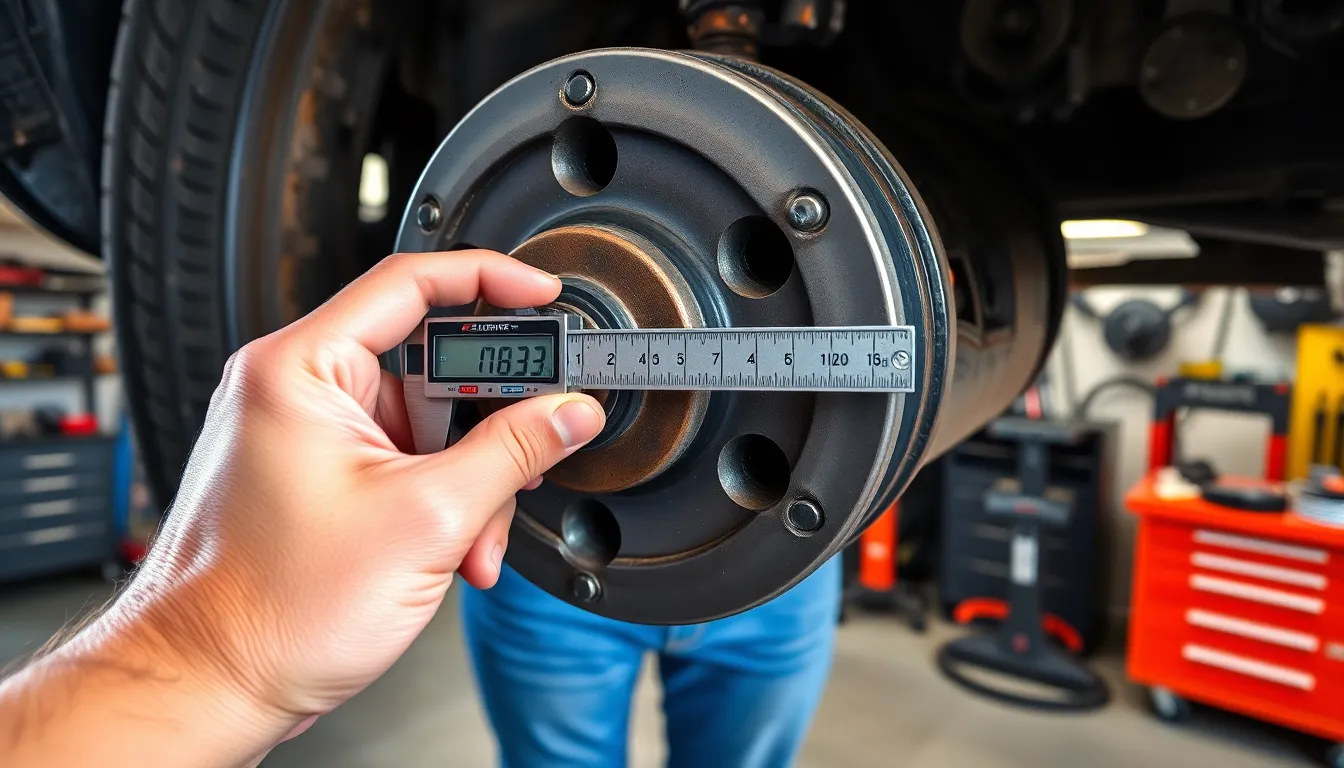When we’re shopping for new wheels or replacing damaged ones, understanding how to measure a bolt pattern becomes absolutely crucial. Getting this measurement wrong means we’ll end up with wheels that simply won’t fit our vehicle – a costly mistake that’s easily avoidable with the right knowledge.
A bolt pattern determines how wheel bolts are arranged on your vehicle’s hub, and it’s one of the most important specifications we need to know before making any wheel purchase. Whether we’re dealing with a 4-lug, 5-lug, 6-lug, or 8-lug pattern, each requires a exact measuring technique to ensure perfect fitment.
We’ll walk you through the exact steps to measure your bolt pattern accurately, using simple tools you probably already have at home. By the end of this guide, you’ll confidently measure any bolt pattern and make informed decisions when selecting new wheels for your car, truck, or SUV.
What Is a Bolt Pattern and Why It Matters
Bolt patterns represent the exact arrangement of bolt holes on a vehicle’s wheel hub that secure wheels to the axle. The measurement consists of two key components: the number of bolt holes and the diameter of the circle formed by the center points of these holes.
Vehicle manufacturers design bolt patterns as standardized specifications that ensure proper wheel fitment and safe operation. Each pattern follows a precise geometric configuration where bolt holes are positioned at equal intervals around a theoretical circle called the pitch circle diameter (PCD).
Common bolt pattern configurations include:
- 4-bolt patterns – typically found on compact cars and economy vehicles
- 5-bolt patterns – standard on most passenger cars and light trucks
- 6-bolt patterns – common on larger trucks and SUVs
- 8-bolt patterns – primarily used on heavy-duty trucks and commercial vehicles
Proper bolt pattern matching ensures critical safety functions including wheel centering, load distribution, and secure attachment. Mismatched patterns can result in wheel wobble, premature bearing wear, and potential wheel separation during operation.
Performance considerations extend beyond basic fitment since incorrect bolt patterns affect vehicle handling characteristics. Wheels with improper bolt patterns may not sit flush against the hub surface, creating gaps that compromise the wheel’s structural integrity.
Cost implications make accurate bolt pattern identification essential before purchasing new wheels. Custom modifications or adapters required for mismatched patterns can add hundreds of dollars to wheel installation costs while potentially voiding vehicle warranties.
Hub-centric designs in modern vehicles require precise bolt pattern alignment to maintain the factory-engineered relationship between the wheel and suspension components. This relationship directly impacts steering response, brake performance, and overall vehicle stability.
Tools You’ll Need to Measure Bolt Pattern
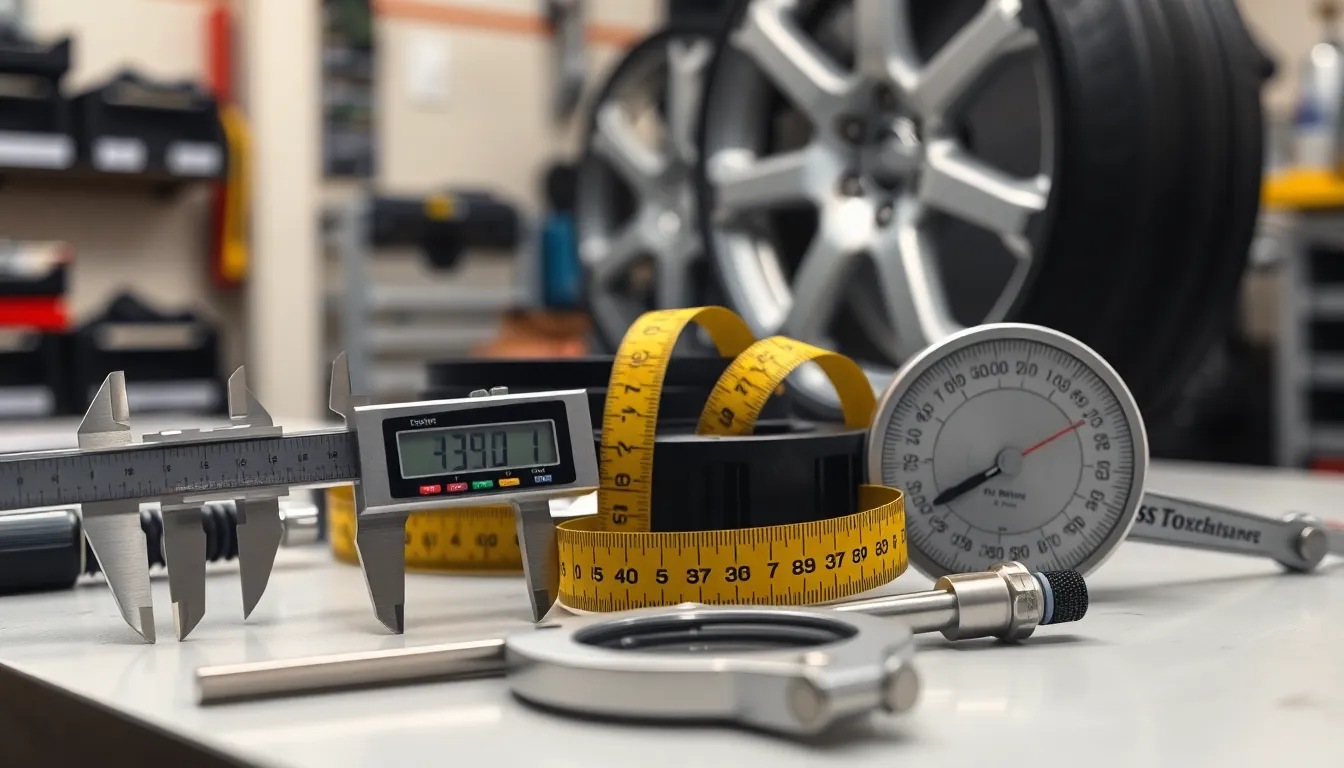
Measuring bolt patterns accurately requires exact tools that deliver precise measurements for safe wheel fitment. We recommend gathering these essential items before starting your measurement process.
Calipers serve as the primary tool for measuring lug hole diameters with precision down to thousandths of an inch. Digital calipers provide the most accurate readings and eliminate guesswork when determining exact hole specifications.
Measuring tape offers a reliable method for determining distances between lug holes on larger bolt patterns. Standard measuring tapes work effectively for most passenger vehicles, while metric tapes provide measurements in millimeters for European specifications.
Bolt pattern measuring tools deliver specialized functionality designed specifically for automotive wheel measurements. These tools feature calibrated scales and reference points that simplify the measurement process across different lug configurations.
Bolt pattern gauges represent the most precise option available for professional level accuracy. These specialized instruments contain tapered pins that fit directly into lug holes, eliminating measurement errors and providing exact bolt circle diameters.
| Tool Type | Accuracy Level | Best Use Case |
|---|---|---|
| Calipers | ±0.001 inches | Lug hole diameter measurement |
| Measuring Tape | ±1/16 inches | Distance between opposite lugs |
| Bolt Pattern Tool | ±1/32 inches | General bolt pattern measurement |
| Bolt Pattern Gauge | ±0.005 inches | Professional precision measurement |
Additional supplies include a clean rag for removing dirt from lug holes and a notepad for recording measurements. Clean measurement surfaces ensure accurate readings, while documented measurements prevent confusion during wheel shopping.
Professional mechanics typically use bolt pattern gauges for their superior accuracy, while DIY enthusiasts find measuring tapes and calipers sufficient for most applications. The investment in quality measuring tools pays dividends through accurate measurements that prevent costly wheel fitment mistakes.
How to Identify the Number of Bolt Holes

Identifying the number of bolt holes represents the first step in measuring any vehicle’s bolt pattern. We examine the wheel hub directly to count each individual lug hole that secures the wheel to the axle assembly.
Visual Inspection Method
Visual inspection provides the most straightforward approach for counting bolt holes. We position ourselves in front of the wheel and systematically count each lug hole moving clockwise around the hub. Most vehicles feature one of four standard configurations:
- 4-lug patterns: Common on compact cars and small vehicles
- 5-lug patterns: Standard on most passenger cars and light trucks
- 6-lug patterns: Typical for larger trucks and SUVs
- 8-lug patterns: Found on heavy-duty trucks and commercial vehicles
Counting Techniques for Accuracy
Counting techniques ensure we don’t miss or double-count any bolt holes during inspection. We start from the topmost lug hole and mark it mentally or physically as our reference point. Moving clockwise, we count each subsequent hole until returning to our starting position.
Alternative counting methods include using a finger to trace each hole while counting aloud. We can also take a photograph of the wheel hub to reference later if uncertainty arises during the initial count.
Common Bolt Hole Configurations
| Number of Bolts | Vehicle Types | Typical Applications |
|---|---|---|
| 4 | Compact cars, economy vehicles | Honda Civic, Toyota Corolla |
| 5 | Passenger cars, light trucks | Ford F-150, Chevrolet Silverado 1500 |
| 6 | Mid-size trucks, SUVs | Chevrolet Silverado 1500, Ford F-150 |
| 8 | Heavy-duty trucks, commercial vehicles | Ford F-250, Chevrolet Silverado 2500 |
Verification Steps
Verification steps confirm our initial count and prevent measurement errors. We repeat the counting process a second time using the opposite direction (counterclockwise) to ensure consistency. Double-checking eliminates potential mistakes that could lead to purchasing incompatible wheels.
Physical verification involves gently touching each lug hole while counting to provide tactile confirmation of our visual assessment. This method proves particularly useful when dealing with dirty or obscured wheel hubs where visual identification might be challenging.
Measuring 4-Lug and 6-Lug Bolt Patterns

Even numbered lug patterns like 4 lug and 6 lug configurations use a straightforward measurement approach. We measure directly from the center of one bolt hole to the center of the bolt hole positioned directly across from it.
Center-to-Center Method for Even-Numbered Patterns
Identifying the center points of opposing bolt holes marks the starting point for accurate measurements. We locate two bolt holes that sit directly across from each other on the hub assembly. The measurement process involves positioning our measuring tool at the exact center of the first bolt hole and extending it to the center of the opposite hole.
Recording this distance gives us the diameter of the imaginary circle formed by all lug holes. This measurement represents the bolt circle diameter that manufacturers use as a standard specification. We ensure our measuring tool remains perpendicular to the hub surface throughout the process to maintain accuracy.
Verification involves taking multiple measurements between different opposing hole pairs to confirm consistency. Each measurement should produce identical results when the bolt pattern is correctly manufactured.
Using a Bolt Pattern Gauge
Bolt pattern gauges eliminate guesswork by providing precise templates for measurement verification. These specialized tools feature multiple circular patterns that align with standard bolt configurations used across different vehicle manufacturers. We position the gauge over the hub assembly and identify which template circle matches our lug hole arrangement.
Professional mechanics rely on these gauges for complex patterns where traditional measuring methods prove challenging. The tool’s accuracy becomes particularly valuable when working with aftermarket wheels that require exact specifications. Different gauge models accommodate various bolt pattern sizes and configurations commonly found in automotive applications.
Template matching with a bolt pattern gauge provides instant verification without mathematical calculations. We simply align the gauge holes with our vehicle’s lug holes to determine the correct pattern measurement.
Measuring 5-Lug and Odd-Numbered Bolt Patterns

Odd numbered bolt patterns require different measuring techniques than even numbered configurations. The asymmetrical arrangement of bolt holes in 5-lug and other odd patterns means we can’t measure directly between opposing holes like we do with 4-lug or 6-lug patterns.
Center-to-Center Skip Method
This method works for odd numbered patterns by adapting the traditional center-to-center approach used for even patterns. We select any lug hole as our starting reference point and measure to the outer edge of the bolt hole positioned directly across from it.
The measurement from center to opposite edge provides the bolt circle diameter for odd configurations. For example, when we measure 114.3mm using this technique on a 5-lug wheel, we record the bolt pattern as 5×114.3mm.
This approach accounts for the uneven spacing inherent in odd numbered lug patterns. We skip the intermediate bolt holes between our starting point and target measurement location to ensure accuracy.
Measuring from Center to Bolt Hole
We position our measuring tool at the exact center of one bolt hole when using this technique. The measurement extends from this center point to the outside edge of the bolt hole positioned directly across the hub.
This method specifically addresses the challenge of odd numbered patterns where no bolt hole sits directly opposite another. We locate the bolt hole that appears most directly across from our starting position and measure to its outer perimeter.
The measurement captures the full diameter of the bolt circle even though we’re measuring to an edge rather than another center point. We record this distance as our bolt circle diameter and combine it with the lug count to establish the complete bolt pattern specification.
Accuracy remains critical when measuring to the outer edge of the target bolt hole. We ensure our measuring tool contacts the precise edge of the hole rather than extending beyond or falling short of the actual opening.
Common Bolt Pattern Sizes and Applications
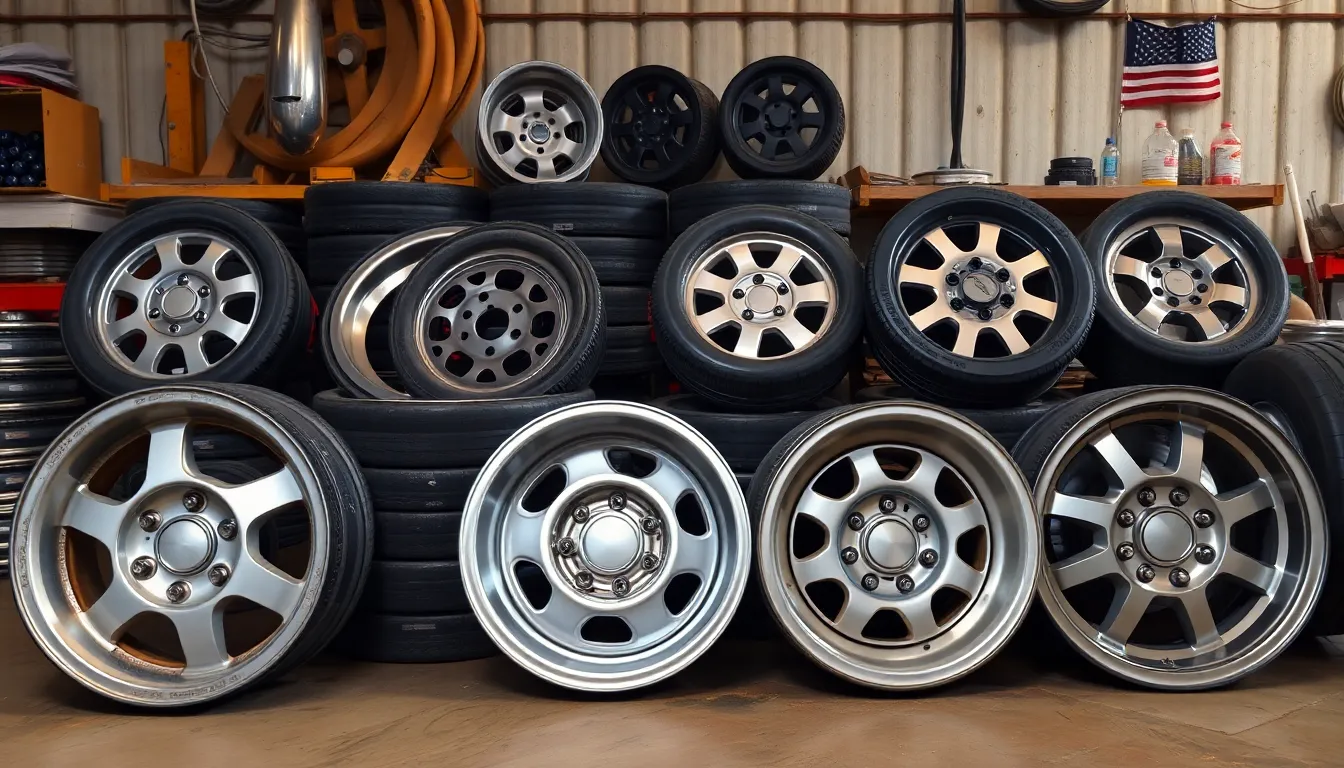
Vehicle manufacturers standardize bolt patterns across different vehicle categories to ensure proper wheel fitment and safety. Understanding these standard configurations helps us identify the correct pattern for exact vehicle types.
4-lug bolt patterns appear primarily on compact cars and smaller vehicles. These patterns typically measure between 100mm to 114.3mm in diameter. Manufacturers like Honda use 4x100mm patterns on models such as the Civic and Accord from earlier generations.
5-lug configurations dominate the passenger vehicle market across sedans, coupes, and crossovers. The 5×114.3mm pattern remains the most widespread specification, appearing on vehicles from Toyota, Ford, and General Motors. Alternative 5-lug measurements include 5x100mm for some Subaru models and 5x120mm for BMW vehicles.
6-lug patterns serve larger trucks and SUVs that require additional load capacity. The 6×139.7mm specification appears on popular models like the Chevrolet Silverado and Toyota Tacoma. Ford utilizes a 6x135mm pattern on their F-150 series trucks.
8-lug arrangements support heavy duty trucks and commercial vehicles designed for maximum load bearing. The 8×165.1mm pattern appears on models like the Chevrolet 2500HD and GMC Sierra 2500. Ford’s Super Duty series employs an 8x170mm specification for their largest trucks.
| Lug Count | Common Diameter (mm) | Typical Vehicle Types | Example Models |
|---|---|---|---|
| 4 | 100, 114.3 | Compact cars, older models | Honda Civic, Toyota Corolla |
| 5 | 100, 114.3, 120 | Passenger vehicles, light trucks | Toyota Camry, Ford Mustang |
| 6 | 135, 139.7 | Trucks, large SUVs | Ford F-150, Chevy Silverado |
| 8 | 165.1, 170 | Heavy duty trucks | GMC 2500HD, Ford Super Duty |
Regional variations exist within these standard patterns. European vehicles often use metric measurements like 5x112mm, while domestic manufacturers favor imperial derived specifications. Luxury brands frequently employ unique patterns such as 5x130mm for Porsche vehicles.
Accurate identification of these patterns prevents costly fitment errors when selecting aftermarket wheels. Professional wheel retailers reference these standard specifications to match compatible wheels with exact vehicle applications.
Tips for Accurate Bolt Pattern Measurement
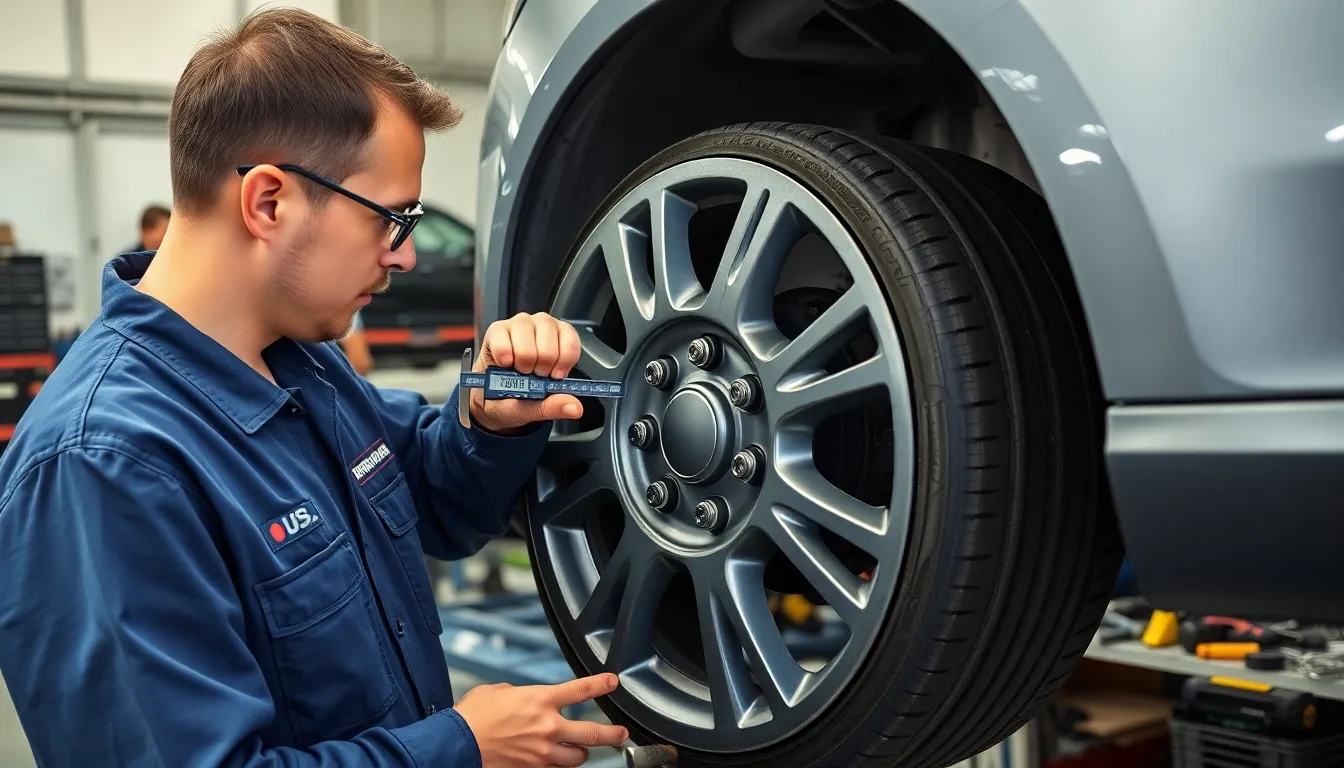
Precise bolt pattern measurement techniques prevent costly wheel fitment errors and ensure optimal vehicle safety. Professional installers and DIY enthusiasts rely on exact methods to achieve measurement accuracy within 0.1 inches.
Avoiding Common Measurement Mistakes
Digital calipers eliminate guesswork when measuring lug hole centers and provide consistent results across multiple measurements. Measuring from the wrong reference points leads to inaccurate bolt pattern specifications that can result in incompatible wheel purchases.
Remove wheels completely from the vehicle before taking measurements to access all lug holes clearly. Many enthusiasts attempt measurements with wheels partially mounted, creating obstructed views and skewed angle readings.
Straight measurement tools prevent angular errors that occur when using flexible measuring tapes on curved surfaces. Bolt pattern gauges designed specifically for automotive applications offer templated precision that standard rulers cannot match.
Proper lug identification requires counting all visible holes rather than assuming standard configurations. Some vehicles feature decorative caps or covers that conceal additional mounting points, leading to incorrect lug counts.
Clean measurement surfaces before taking readings to remove dirt, rust, or debris that can affect caliper positioning. Contaminated surfaces create false readings that compound into important measurement errors.
Double-Checking Your Results
Multiple measurement techniques confirm initial readings and identify potential errors before wheel selection. Cross-reference center-to-center measurements with bolt pattern gauge readings to validate accuracy.
Record measurements immediately in a notepad to prevent memory errors during the wheel shopping process. Document both the number of lugs and the precise diameter measurement for complete pattern specification.
Online verification tools allow comparison of measured results against manufacturer specifications for exact vehicle makes and models. Input your vehicle’s year, make, and model to confirm measured bolt patterns match factory specifications.
Professional confirmation from tire shops or automotive retailers provides final validation before purchasing expensive aftermarket wheels. Many retailers offer free bolt pattern verification services using professional-grade measuring equipment.
Repeat measurements at different lug positions ensure consistency across the entire bolt circle. Take three separate measurements and calculate the average to eliminate single-point measurement errors.
When to Consult a Professional
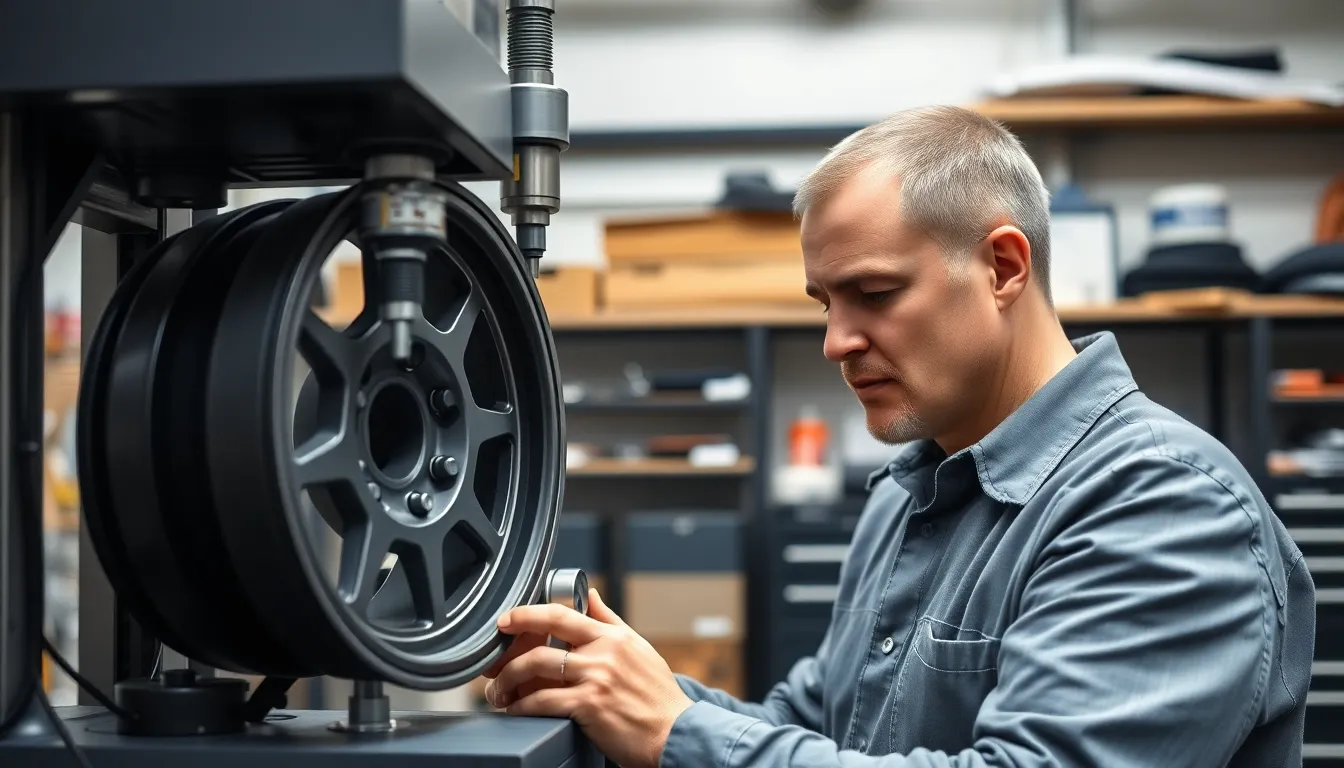
Complex bolt patterns with irregular spacing require specialized expertise that goes beyond basic measuring techniques. Professional mechanics and wheel specialists use Coordinate Measuring Machines (CMM) to achieve precision levels that standard home tools cannot match.
High performance vehicles and custom wheel applications demand exact measurements where even minor variations can compromise safety and fitment. Precision tools employed by professionals ensure measurements within thousandths of an inch, critical for maintaining proper vehicle handling and brake performance.
Uncertainty about measurement results indicates the need for professional verification before purchasing expensive aftermarket wheels. Experienced wheel specialists can quickly identify bolt patterns and confirm compatibility with exact vehicle applications.
| Professional Service | Equipment Used | Accuracy Level | Best For |
|---|---|---|---|
| Tire Shop | Digital Calipers + Templates | ±0.5mm | Standard Vehicles |
| Wheel Specialist | CMM + Laser Tools | ±0.1mm | Custom Applications |
| Dealership Service | Manufacturer Tools | OEM Specification | Warranty Work |
Safety concerns arise when bolt pattern measurements seem inconsistent across multiple attempts using different techniques. Professional confirmation eliminates guesswork and prevents potential wheel separation incidents that could result from incorrect fitment.
Custom wheel installations often involve unique bolt patterns or adapter requirements that require professional assessment. Specialists can recommend appropriate answers while maintaining vehicle safety standards and warranty coverage.
Irregular lug hole spacing found on some European luxury vehicles presents measurement challenges that benefit from professional identification. These specialists maintain databases of manufacturer specifications that ensure accurate pattern identification.
Time constraints make professional measurement services cost effective when compared to purchasing multiple measuring tools for a single wheel change. Most tire shops provide bolt pattern verification at minimal cost or include it with wheel installation services.
Conclusion
Measuring your vehicle’s bolt pattern accurately ensures you’ll select the right wheels every time. We’ve covered the essential tools and techniques that make this process straightforward whether you’re dealing with even or odd-numbered lug configurations.
Remember that precision matters when it comes to wheel fitment and safety. Taking multiple measurements and verifying your results helps prevent costly mistakes and ensures optimal vehicle performance.
When you’re confident in your measurements you can shop for wheels with complete certainty. If you encounter any uncertainty during the process don’t hesitate to seek professional confirmation – it’s always better to verify than to guess when it comes to your vehicle’s safety and performance.
Frequently Asked Questions
What is a bolt pattern and why is it important?
A bolt pattern is the arrangement of bolt holes on a vehicle’s wheel hub that secures wheels to the axle. It consists of the number of bolt holes and the diameter of the circle formed by their center points. Proper bolt pattern matching is crucial for safety, as mismatched patterns can lead to wheel wobble, premature bearing wear, potential wheel separation, and affect vehicle handling and structural integrity.
What tools do I need to measure my vehicle’s bolt pattern?
You’ll need calipers for measuring lug hole diameters, measuring tapes for distances between lug holes, and specialized bolt pattern measuring tools or gauges for professional-level accuracy. Additional supplies include a clean rag and notepad for recording measurements. Digital calipers provide the most consistent results for precise measurements.
How do I count the number of bolt holes on my wheel?
Perform a visual inspection by counting all visible bolt holes around the hub. Mark a reference point and count systematically, using tactile confirmation if needed. Common configurations include 4-lug (compact cars), 5-lug (passenger vehicles), 6-lug (larger trucks/SUVs), and 8-lug (heavy-duty trucks). Always double-check your count to prevent errors.
How do I measure 4-lug and 6-lug bolt patterns?
For 4-lug and 6-lug patterns, use the center-to-center method by measuring directly between opposing bolt holes to get the bolt circle diameter. Since these patterns have even numbers, opposing holes align perfectly. Bolt pattern gauges can also provide precise templates for measurement verification without complex calculations.
How do I measure 5-lug and other odd-numbered bolt patterns?
Use the Center-to-Center Skip Method for odd-numbered patterns. Select a reference point and measure from the center of one bolt hole to the outer edge of the bolt hole positioned most directly across the hub. This accounts for the asymmetrical arrangement and captures the full diameter of the bolt circle accurately.
What are the most common bolt pattern sizes?
Common patterns include 4-lug for compact cars (Honda Civic), 5-lug for most passenger vehicles (Toyota Camry), 6-lug for larger trucks (Ford F-150), and 8-lug for heavy-duty trucks (GMC 2500HD). European vehicles often use metric measurements, while luxury brands may employ unique specifications. Always verify your specific vehicle’s pattern.
When should I consult a professional for bolt pattern measurement?
Consult a professional for complex bolt patterns with irregular spacing, high-performance vehicles, custom applications, or when you’re uncertain about your measurements. Professional mechanics use advanced tools like Coordinate Measuring Machines (CMM) for precision levels that standard home tools cannot match. This prevents costly mistakes and ensures safety.
What are the consequences of using the wrong bolt pattern?
Using incorrect bolt patterns can cause wheel wobble, premature bearing wear, potential wheel separation, compromised vehicle handling, and structural integrity issues. Additionally, custom modifications or adapters can add hundreds of dollars to installation costs and may void warranties. Proper alignment is critical for steering response and brake performance.

